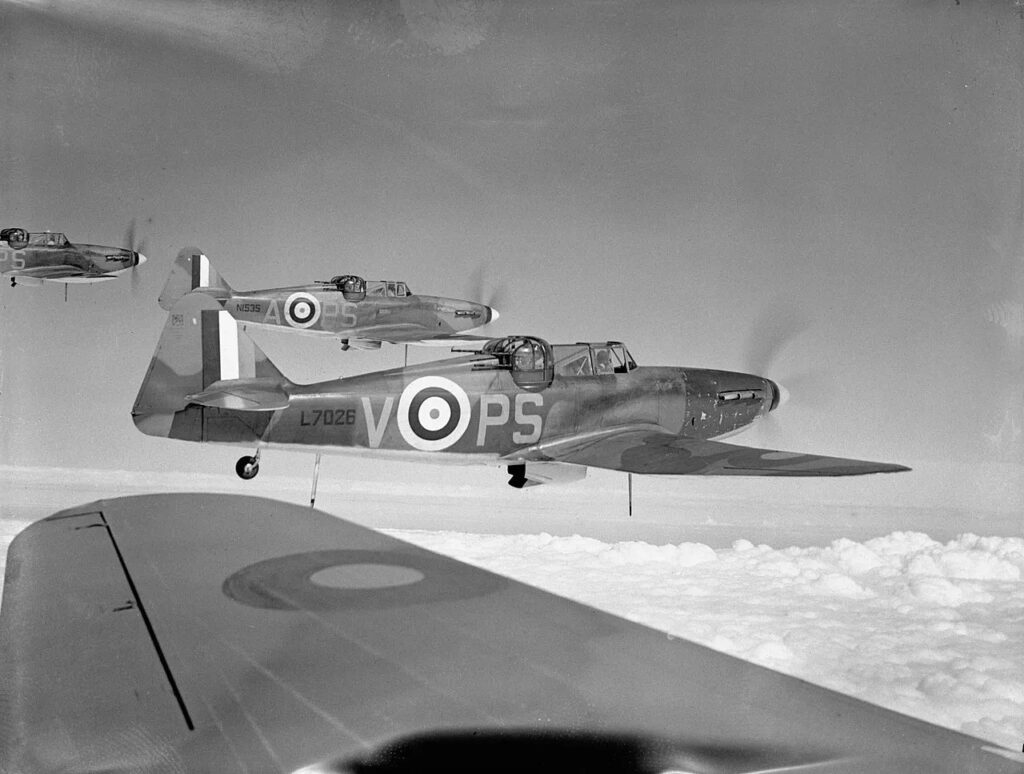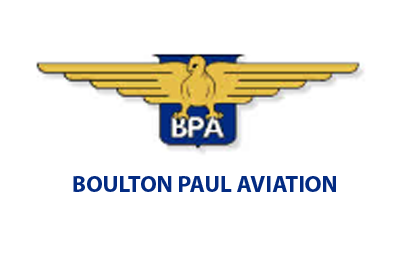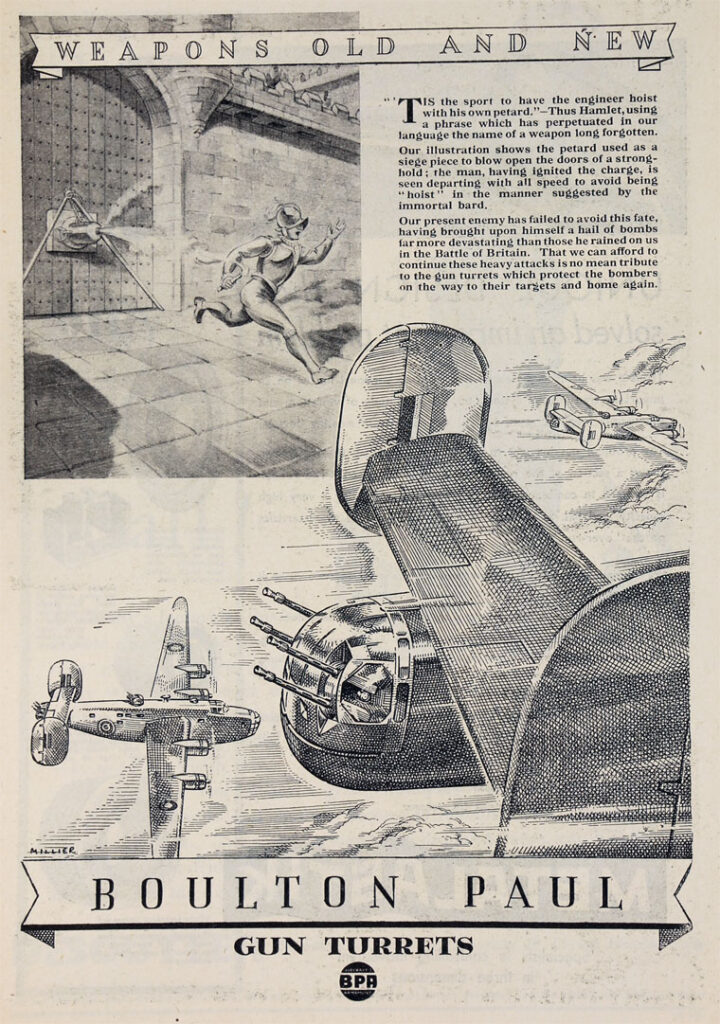Boulton Paul P.82 Defiant
The Boulton Paul P.82 Defiant was a two-seat day/night fighter used by Great Britain in the early years of World War II.
The Defiant was a conventionally constructed aircraft of similar size and design to the Hawker Hurricane. The most unusual feature was the method of attaching light alloy skins to stringers and ribs, before these were attached to the fuselage frame and wing spars. This avoided the need to preform the skins, which were riveted while flat and using countersunk holes, creating an exceptional surface finish. The fuselage was built on two sections. The forward part was built up of four L section longerons and several bulkheads, while the rear part consisted of two side panels and the top decking


The Defiant failed by day, but when the Luftwaffe turned to night operations, presenting the R.A.F. with a formidable problem, it found its forte, filling a gap in Britain’s defences until more advanced night interceptors became available.
Development of the Defiant began in 1935, when the British Air Ministry issued Specification F.9/35 to meet the requirement for a two-seat fighter which concentrated the main armament in a revolving powered turret, and possessed a speed capability similar to the single seat fighters then beginning to enter service.
The Defiant was an aircraft of exceptional qualities and an excellent flying machine, and as the world’s first fighter to have an enclosed power-driven turret it made its mark on history. It was hardly to be expected that the Defiant, penalised by the weight and high drag of even such a compact turret as that evolved by Boulton Paul and possessing a motor of only the same power as that of the very much lighter Hurricanes and Spitfires, would compete in performance and agility with contemporary single-seaters, and it was not the fault of the design team that their product was born of an outmoded philosophy.


Five manufacturers submitted proposals to meet F.9/35, with two of them being selected in the Autumn of 1935 to build one prototype each – Boulton Paul Aircraft with the Defiant, and Hawker Aircraft Ltd with the Henley derived Hotspur. However, due to their Hurricane commitments, Hawker were unable to build the Hotspur prototype until 1937, which also made it impossible to spare any effort to bring the Hotspur prototype up to service standard. This eventually led to development of the Hotspur being discontinued in favor of the Defiant
The First Defiant prototype – K8310 – was flown by Boulton Paul’s chief test pilot Cecil Feather on August 11, 1937. Due to delays with the turret, the Defiant was initially flown as a single seater, with the turret well faired over and carrying ballast in place of the turret and second crew member.
When tested at Martesham against the Hotspur – with both types carrying similar ballast loads and a wooden mockup of the turret – the Defiant was found to be heavier and slower than the Hawker aircraft.
As Defiants were released from the night fighter role they were handed over to R.A.F. Fighter Command air-sea rescue units, largely supplanting the Lysander. Two “M”-type rescue dinghies were carried in containers beneath the wings, and the fifty or so Defiants converted for the air-sea rescue role served with Nos. 275, 276, 277, 278 and 281 Squadrons. Their suitability for the role was questionable as their wide turning circle and high stalling speed were distinct disadvantages on A.S.R. operations. However, maintenance problems necessitated their withdrawal after some six months.
Defiant production ended with a run of 140 examples of a target-towing variant ordered in July 1941 as the T.T.Mk.I. The turret was removed and replaced by a fixed canopy over the winch operator’s cockpit, and a “B” or “E” type winch was attached to the side of the fuselage and driven by a “windmill” on the fuselage starboard side, and target sleeves were carried in a pack under the rear fuselage. Based on the Defiant II, the first T.T.Mk.I (DR863) was completed at the end of 1941, and deliveries occupied most of 1942. The last forty Mk. II fighters were also converted as T.T.Mk. Is and, subsequently, 150 Defiant Is with Merlin III engines were converted as target tugs following a successful trial conversion of N3488 in mid-1942, and designated T.T.Mk. III. The designation T.T.Mk. II was reserved for a proposed production variant with a 1,620 h.p. Merlin 24 engine. The Defiant performed the unglamorous but vital task of target tug throughout the remainder of the war years, serving at air gunnery training schools and many fighter and bomber O.T.U.s. Some sixty Defiant target tugs were transferred to the Royal Navy, while two others, including DR945, were flown in mixed RAF/US Insignia by the 11th Combat Crew Replacement Centre, United States Army Air Force 326th Bombardment Squadron, based at Bovingdon.
. General characteristics
- Crew: two: pilot, gunner
- Length: 35 ft 4 in (10.77 m)
- Wingspan: 39 ft 4 in (11.99 m)
- Height: 11 ft 4 in (3.45 m)
- Wing area: 250 sq ft (23 m2)
- Empty weight: 6,078 lb (2,757 kg)
- Gross weight: 8,318 lb (3,773 kg)
- Max takeoff weight: 8,600 lb (3,901 kg)
- Powerplant: 1 × Rolls-Royce Merlin III liquid-cooled V12 engine, 1,030 hp (770 kW)
- Propellers: 3-bladed
Performance
- Maximum speed: 304 mph (489 km/h, 264 kn) at 17,000 ft (5,200 m)
- Cruise speed: 175 mph (282 km/h, 152 kn) at 15,000 ft (4,600 m)
- Range: 465 mi (748 km, 404 nmi)
- Endurance: 1hr 47min
- Service ceiling: 31,000 ft (9,400 m) [67]
- Time to altitude: 8.5 min to 15,000 ft (4,600 m)
Armament
- Guns: 4 × 0.303 in (7.7 mm) Browning machine guns in hydraulically powered dorsal turret (600 rpm)


